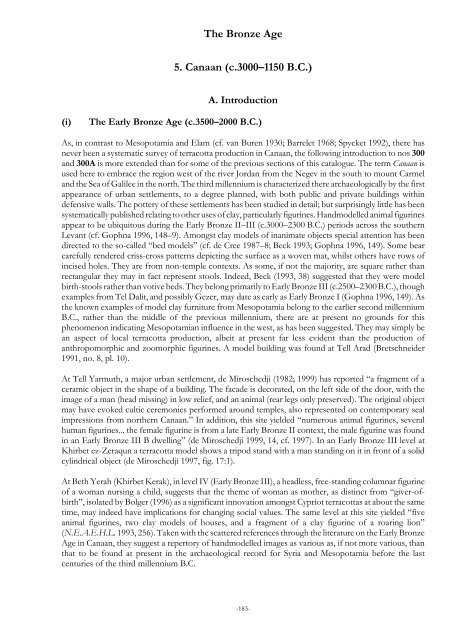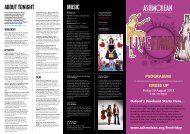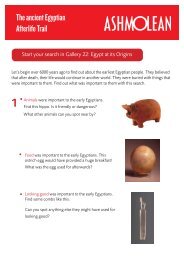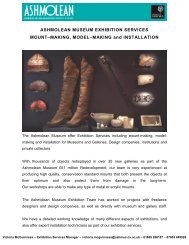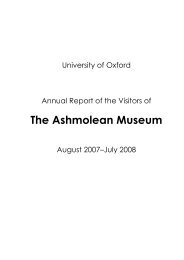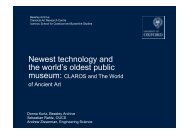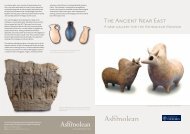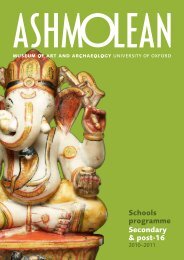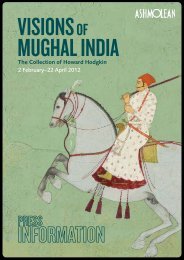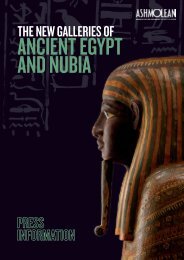The Bronze Age: Canaan - The Ashmolean Museum
The Bronze Age: Canaan - The Ashmolean Museum
The Bronze Age: Canaan - The Ashmolean Museum
You also want an ePaper? Increase the reach of your titles
YUMPU automatically turns print PDFs into web optimized ePapers that Google loves.
<strong>The</strong> <strong>Bronze</strong> <strong>Age</strong><br />
5. <strong>Canaan</strong> (c.3000–1150 B.C.)<br />
A. Introduction<br />
(i)<br />
<strong>The</strong> Early <strong>Bronze</strong> <strong>Age</strong> (c.3500–2000 B.C.)<br />
As, in contrast to Mesopotamia and Elam (cf. van Buren 1930; Barrelet 1968; Spycket 1992), there has<br />
never been a systematic survey of terracotta production in <strong>Canaan</strong>, the following introduction to nos 300<br />
and 300A is more extended than for some of the previous sections of this catalogue. <strong>The</strong> term <strong>Canaan</strong> is<br />
used here to embrace the region west of the river Jordan from the Negev in the south to mount Carmel<br />
and the Sea of Galilee in the north. <strong>The</strong> third millennium is characterized there archaeologically by the first<br />
appearance of urban settlements, to a degree planned, with both public and private buildings within<br />
defensive walls. <strong>The</strong> pottery of these settlements has been studied in detail; but surprisingly little has been<br />
systematically published relating to other uses of clay, particularly figurines. Handmodelled animal figurines<br />
appear to be ubiquitous during the Early <strong>Bronze</strong> II–III (c.3000–2300 B.C.) periods across the southern<br />
Levant (cf. Gophna 1996, 148–9). Amongst clay models of inanimate objects special attention has been<br />
directed to the so-called “bed models” (cf. de Cree 1987–8; Beck 1993; Gophna 1996, 149). Some bear<br />
carefully rendered criss-cross patterns depicting the surface as a woven mat, whilst others have rows of<br />
incised holes. <strong>The</strong>y are from non-temple contexts. As some, if not the majority, are square rather than<br />
rectangular they may in fact represent stools. Indeed, Beck (1993, 38) suggested that they were model<br />
birth-stools rather than votive beds. <strong>The</strong>y belong primarily to Early <strong>Bronze</strong> III (c.2500–2300 B.C.), though<br />
examples from Tel Dalit, and possibly Gezer, may date as early as Early <strong>Bronze</strong> I (Gophna 1996, 149). As<br />
the known examples of model clay furniture from Mesopotamia belong to the earlier second millennium<br />
B.C., rather than the middle of the previous millennium, there are at present no grounds for this<br />
phenomenon indicating Mesopotamian influence in the west, as has been suggested. <strong>The</strong>y may simply be<br />
an aspect of local terracotta production, albeit at present far less evident than the production of<br />
anthropomorphic and zoomorphic figurines. A model building was found at Tell Arad (Bretschneider<br />
1991, no. 8, pl. 10).<br />
At Tell Yarmuth, a major urban settlement, de Miroschedji (1982; 1999) has reported “a fragment of a<br />
ceramic object in the shape of a building. <strong>The</strong> facade is decorated, on the left side of the door, with the<br />
image of a man (head missing) in low relief, and an animal (rear legs only preserved). <strong>The</strong> original object<br />
may have evoked cultic ceremonies performed around temples, also represented on contemporary seal<br />
impressions from northern <strong>Canaan</strong>.” In addition, this site yielded “numerous animal figurines, several<br />
human figurines... the female figurine is from a late Early <strong>Bronze</strong> II context, the male figurine was found<br />
in an Early <strong>Bronze</strong> III B dwelling” (de Miroschedji 1999, 14, cf. 1997). In an Early <strong>Bronze</strong> III level at<br />
Khirbet ez-Zeraqun a terracotta model shows a tripod stand with a man standing on it in front of a solid<br />
cylindrical object (de Miroschedji 1997, fig. 17:1).<br />
At Beth Yerah (Khirbet Kerak), in level IV (Early <strong>Bronze</strong> III), a headless, free-standing columnar figurine<br />
of a woman nursing a child, suggests that the theme of woman as mother, as distinct from “giver-ofbirth”,<br />
isolated by Bolger (1996) as a significant innovation amongst Cypriot terracottas at about the same<br />
time, may indeed have implications for changing social values. <strong>The</strong> same level at this site yielded “five<br />
animal figurines, two clay models of houses, and a fragment of a clay figurine of a roaring lion”<br />
(N.E.A.E.H.L. 1993, 256). Taken with the scattered references through the literature on the Early <strong>Bronze</strong><br />
<strong>Age</strong> in <strong>Canaan</strong>, they suggest a repertory of handmodelled images as various as, if not more various, than<br />
that to be found at present in the archaeological record for Syria and Mesopotamia before the last<br />
centuries of the third millennium B.C.<br />
-183-
ANCIENT NEAR EASTERN TERRACOTTAS<br />
(ii)<br />
Early <strong>Bronze</strong> IV to Middle <strong>Bronze</strong> II (c.2300–1650 B.C.)<br />
In the transitional phase between the end of the urban-based cultures of the Early <strong>Bronze</strong> <strong>Age</strong> in <strong>Canaan</strong><br />
and a revival of town-life in Middle <strong>Bronze</strong> IIA, surviving indications of continued human activity are<br />
virtually confined to mortuary contexts, where evidence for imagery of any kind is to all intents and<br />
purposes so far unknown. During this period regular relations between <strong>Canaan</strong> and Egypt, where there<br />
was a two century break in centralised control (“First Intermediate Period”), lapsed (cf. Redford 1992,<br />
57–63).<br />
With the revival of urban life in <strong>Canaan</strong> in the first two centuries of the second millennium B.C. there is<br />
at present little, if any evidence, for a revival of terracotta production before Middle <strong>Bronze</strong> IIB in the<br />
eighteenth to seventeenth centuries B.C. <strong>The</strong> emergence of a <strong>Canaan</strong>ite dominated dynasty (XV) in Egypt<br />
reopened contacts between the two regions. At the same time several significant features in the<br />
archaeological record (mudbrick architecture; new mortuary practices; and ceramic changes) indicate<br />
strong contacts, possible some actual immigration, into <strong>Canaan</strong> from Syria. <strong>The</strong> contrasting cultural and<br />
iconographic influences evident in <strong>Canaan</strong> at this time are exemplified by glyptic, with cylinder seals<br />
illustrating the Syrian ingredient, scarabs the Egyptian. As Keel and Uehlinger (1998, 19) have stressed:<br />
“a person studying Palestine must assume that influences came both from Egypt and the Near East, not<br />
only in regard to matters connected with form and style but also when dealing with semantic issues”.<br />
It would appear that the appearance on <strong>Canaan</strong>ite scarabs at this time of the ‘nude female’, depicted<br />
frontally with her arms down her sides, rather than bent across her abdomen or holding her breasts derives<br />
from the imagery of Syrian seals. Such figurative designs are rare then on Egyptian scarabs. <strong>The</strong> visual<br />
isolation of this figure on scarabs exactly parallels her appearance on baked clay plaques in Mesopotamia<br />
from the late Akkadian Period (c.2150 B.C.) and the self-contained appearance of this motif on Babylonian<br />
cylinder seals of the first centuries of the second millennium B.C.<br />
In the west the so-called Nude Goddess lifting her garments appears first in Syro-Cappadocian and<br />
Anatolian glyptic early in the second millennium B.C. and then more commonly in the “Earlier”<br />
(c.1850–1720 B.C.) rather than in the “Later Syrian Group” of cylinder seals. She does not appear at Tell<br />
Atshana (Alalakh), (cf nos 258 ff) where even the dressed goddess partially revealing herself is rare (cf.<br />
Teissier 1984, 80–1). Barrelet (1955) agreed that the “Winged and Armed Goddess” and the “Nude<br />
Goddess” were all aspects of Ishtar in Syrian glyptic: as goddess of love she is shown revealing herself,<br />
either with her long garment put to one side or by lifting a veil; sometimes both are combined (cf. Teissier<br />
1984, nos 490, 496). Here, as in Babylonia, there remains a degree of ambiguity about the exact status of<br />
this nude female, when neither a horned headdress nor wings indicate divinity in a particular<br />
representation of her.<br />
At present there is no clear evidence that even a sporadic production of zoomorphic terracottas persisted<br />
when anthropomorphic clay images were temporarily eclipsed after the end of the Early <strong>Bronze</strong> <strong>Age</strong>. <strong>The</strong><br />
first type to reappear in clay are doves associated in many ancient Near Eastern cultures with the local<br />
goddess of love. <strong>The</strong> basis for regarding pigeons and doves (the Columbidae family of birds) as models of<br />
lovers is their courtship behaviour, kiss-like billing and cooing, and faithful relationships (cf. Ziffer 1998).<br />
In a Middle <strong>Bronze</strong> II shrine at Nahariyah (Dothan, M. 1956), a coastal site in Northern Israel, clay doves,<br />
generally shown in flight, were the only votives in terracotta, whilst nude female figurines there were in<br />
metal, as at a contemporary shrine at Megiddo (Loud 1948, pl. 245, 18–19; cf. Keel and Uehlinger 1998,<br />
31–37). Male metal figurines are rare at this time and equally absent in clay. At Megiddo (area CC), for<br />
instance, in metal 16 were female, 6 male (Negbi 1976, 131). On contemporary seals in <strong>Canaan</strong> the nude<br />
female is associated with caprids and lions, as well as doves; but at this stage neither she nor her votaries<br />
are apparent in clay images.<br />
-184-
BRONZE AGE: INTRODUCTION – CANAAN<br />
(iii)<br />
Late <strong>Bronze</strong> <strong>Age</strong> (c. 1650–1150 B.C.)<br />
Terracottas related to the Syrian Type Badre MAI:2 (cf. nos 222; 254–7) appear at Tell Taanach in<br />
northern <strong>Canaan</strong> before the end of Middle <strong>Bronze</strong> IIC and were in use there in the Late <strong>Bronze</strong> <strong>Age</strong>. This<br />
type is handmodelled and not highly standardized (cf. Lapp 1964, 39–40; 1967, 35–7; 1969, 45). At much<br />
the same time and again from the north the single open mould was introduced for the manufacture of clay<br />
plaques portraying standing or reclining nude females in low relief, with and without attributes. In spite<br />
of their Egyptianizing features, these figurines in clay do not initially have close parallels in Egypt (cf.<br />
Pinch 1993, pl. 47–8). Variations on this motif are relatively rare throughout the Late <strong>Bronze</strong> <strong>Age</strong> and<br />
other anthropomorphic subjects are exceedingly rare (cf. in general: Keel and Uehlinger 1998, 97–108).<br />
Moulds facilitated mass-production, at least sometimes in direct association with pottery, as in a potter’s<br />
workshop at Tell ed-Duweir (Lachish) (Tufnell 1958, 90–91, 291–3, pl. 49). Kletter (1996, 35, n.8)<br />
suggested a general trend in their development from the earliest which had a wide background (or<br />
surround) that narrowed with time through into the Iron <strong>Age</strong>. <strong>The</strong>n the heads began to protrude more<br />
conspicuously and finally the background disappeared.<br />
Evidence for a contextual study of <strong>Canaan</strong>ite terracottas outside their appearance in public buildings and<br />
graves is also extremely meagre, as Daviau (1993) demonstrated. Regrettably the publications of <strong>Bronze</strong><br />
<strong>Age</strong> houses available to her were very deficient in the relevant information as much of it dates before<br />
excavation methods were rigorous enough to provide it. In this it is inferior to comparable data for the<br />
Iron <strong>Age</strong> analysed by Holladay (1987). Daviau was able to isolate a few animal figurines, one “model<br />
shrine”, and one or two moulded female terracottas (Daviau 1993, 238–4, 287–9, 290, 294, 307) in Late<br />
<strong>Bronze</strong> houses. She reported no reference to clay figurines from Middle <strong>Bronze</strong> <strong>Age</strong> houses, as would be<br />
anticipated if they do not appear until very late in that period. <strong>The</strong> fact that the Late <strong>Bronze</strong> <strong>Age</strong> plaques<br />
were mouldmade, to a very restricted and standard set of patterns, would appear to indicate that there was<br />
now a degree of control being exercised over the creation of popular, relatively cheap imagery. However,<br />
once it was current, at least potentially, anyone could have made a mould from a positive and then<br />
circulated replicas. Until detailed petrographic studies have been made, it may only be assumed that these<br />
plaques were part of the repertory of objects made and distributed by professional potters, rather than by<br />
individual householders. <strong>The</strong>y do not appear to have been amongst the recurrent furnishings of shrines<br />
or temples in <strong>Canaan</strong> (cf. Ottosson 1980). It is over half-a-century since any attempt was made to list<br />
<strong>Canaan</strong>ite terracottas, even the anthropomorphic ones, systematically, as Badre (1980) did for Syria.<br />
Mouldmade plaques showing nude females monopolize the <strong>Canaan</strong>ite repertory of anthropomorphic<br />
images in clay. <strong>The</strong>y have been conventionally classed by scholars in two groups: Qudshu and Astarte<br />
plaques (cf. Keel and Uehlinger 1998, 97–108). In neither case has the identity of the female represented<br />
yet been established beyond reasonable doubt. As none is inscribed, they are better designated simply A<br />
and B.<br />
(a)<br />
Nude Females<br />
(1) Type A: Qudshu Plaques (cf. no. 300)<br />
In this group the nude female appears with attributes (plants, etc.). <strong>The</strong> Egyptian word qdš was once<br />
believed to identify a specific goddess (cf. Albright 1939, 117). It is now translated as an epithet (“Holy;<br />
Holiness”), which might apply to any goddess. Its application here is a modern academic convention,<br />
which may inappropriately give the impression that her identity is known, whereas it derives from the use<br />
of this epithet on Egyptian stelae adjacent to various named goddesses.<br />
She appears as a full-frontal nude female with shoulder-length hair, curling over at the ends in so-called<br />
“Hathor” locks, after the Egyptian goddess of that name who wears them. She is shown with arms bent<br />
holding flowers, usually identified as lotuses on either side of her, and is sometimes also framed by plants,<br />
-185-
ANCIENT NEAR EASTERN TERRACOTTAS<br />
usually identified as papyrus. Her feet point sideways, not forwards. This type of plaque does not appear<br />
to have survived in <strong>Canaan</strong> after the end of the <strong>Bronze</strong> <strong>Age</strong> (unlike the ‘Astarte’ type). This type of nude<br />
female occasionally appears, on metal and terracotta plaques, associated with animals: the lion and the<br />
horse (Keel and Uehlinger 1998, 66–7, figs 70–73). This is the strongest evidence for the nude female in<br />
this category representing a goddess or her cult image through her divine identity might have varied<br />
amongst a range of possible “Mistresses of Animals” (cf. Wiggins 1991); but without a “familiar” animal<br />
or divine headdress she might be a suppliant to the goddess rather than the goddess herself.<br />
(2) Type B: Astarte Plaques (cf. no. 300A)<br />
This category, again a term of convenience, also depicts full-frontal nudes framed by a groove or ridge<br />
round the end of the plaque, which is comparable in shape to the previous type. Both types might have<br />
been laid flat, propped up or held in the hand; none is self-supporting. On this type the hairstyles vary,<br />
with the occasional appearance of headdresses. <strong>The</strong>re are a number of different arm positions: held down<br />
the sides with hands touching hips (the commonest position on comparable figurines in Egypt); with<br />
hands cupped under the breasts, sometimes as if displaying or offering them; with both hands placed on<br />
the abdomen, which is sometimes slightly bulging as in pregnancy; with one hand held downwards<br />
touching or indicating the genitals and the other bent at the elbow with the hand on a breast. On this type<br />
the feet are commonly together, pointing forward. <strong>The</strong>y have no attributes. This type survived into the<br />
Iron <strong>Age</strong>.<br />
Miram Tadmor (1982) has argued that the figure is represented as if reclining and is most commonly<br />
found in tombs, consequently relating them to the so-called “concubine figures” of Egyptian tombs and<br />
to limestone examples from the cemetery at Deir el Balah (Dothan, T. 1979). But Keel and Uehlinger<br />
(1998, 100ff.) have demonstrated that eighty per cent of published Late <strong>Bronze</strong> <strong>Age</strong> graves do not include<br />
clay plaques and even when they appear in family graves, there are only one or two. <strong>The</strong> vast majority,<br />
complete and fragmentary, are recovered from family living quarters or in debris. When they appear in<br />
graves it is then as “household goods”, in common with the other ceramic equipment. Moreover, Pinch<br />
(1983) has convincingly deconstructed the old arguments for identifying such figurines as “concubines”<br />
in Egyptian tombs, not least since they are not invariably associated with male skeletons in graves there.<br />
Few questions in the study of terracottas in the ancient Near East, as will be evident from the earlier<br />
section on the Babylonian nude female plaques, is more difficult to resolve and therefore more contentious<br />
than the problem of her (or their) identity when no attributes identify a goddess. Keel and Uehlinger<br />
(1998, 108) take the radical approach by arguing that: “the modern question about whether a figurine<br />
represents a goddess or a woman, posing strict alternatives, is too short-sighted. <strong>The</strong> plaques portray the<br />
goddess as a woman, and conversely they identify the female worshippers... with the goddess.” <strong>The</strong>re is,<br />
however, no unambiguous evidence that they were exclusively associated with women rather than with<br />
men, who also petitioned goddesses in the context of sex and family life. Moreover, it is not evident that<br />
the modern concept of a “role model” is appropriate even for women. Ancient goddesses, particularly<br />
Ishtar (who was also a warrior goddess) and her cognates in the Levant, had diverse functions and may<br />
have been worshipped by men and women for different purposes. Van der Toorn (1998, 94) conceived<br />
these images as “reflections of official cult images or symbols, used outside the cult for devotional and<br />
prophylactic purposes”. This would accord with the view of some Egyptologists that contemporary<br />
popular imagery showing divinities there represent well-known cult images of them, not the deity him or<br />
herself (cf. Schulmann 1981).<br />
This line of argument would be strengthened if it could be demonstrated that the “frame” does not<br />
represent the edges of a bed, but rather an architectural feature. In other words, she stands rather than<br />
reclines, as indeed the feet together, facing forward, is seen to indicate in other contexts when the nude<br />
female is set on a small podium. This would then present the image set in a shrine. Keel and Uehlinger<br />
(1998, 101–105) have explored this possibility in the light of some ceramic plaques of such shrine fronts<br />
in which the clearly depicted architectural elements confound any suggestion that these figures recline<br />
-186-
BRONZE AGE: INTRODUCTION – CANAAN<br />
rather than stand. Complications enter in, however, with the appearance of apparently identical pairs of<br />
nude females within shrines, as at Tell Qasile in Iron <strong>Age</strong> IB, late in the eleventh century (Mazar 1980,<br />
82–4, pl. 30; Bretschneider 1991, 128ff., 229, no. 79), and when the nude female appears with a child in<br />
an “architectural” context (Mazar 1985). Are they goddesses or suppliants<br />
<strong>The</strong> “goddess or her image” problem arises in Egypt with popular worship of Hathor, the local goddess<br />
of women. As Pinch (1993, 94–5) points out “it is difficult to decide whether many votive stelae show a<br />
deity or the deity’s manifestation in a sacred animal or a cult image or object. When Hathor is shown<br />
enclosed in a shrine or standing on a plinth, a statue is meant. <strong>The</strong> depiction of such statues on New<br />
Kingdom votive statue could be due to a lingering reluctance to show living, private individuals in the<br />
presence of a deity”.<br />
In <strong>Canaan</strong>, as elsewhere, in the ancient Near East, the cult statues in major shrines were much more than<br />
simple representations of deities. <strong>The</strong>y were made and repaired according to elaborate prescriptions which<br />
transformed the lifeless image into a living incarnation of the deity in contemporary eyes and minds. <strong>The</strong>y<br />
were then treated exactly as Kings and Queens. <strong>The</strong> consubstantiality of deity and image might only be<br />
destroyed through elaborate rituals. Popular images in clay were of an entirely different order. When they<br />
show a deity it is in all probability a famous cult statue not the deity per se that is intended; when a mortal<br />
then a devotee or suppliant. <strong>The</strong> problem in this case is being certain that type A represents a goddess and<br />
type B a suppliant (or vice versa). Since in Egypt both goddesses and women hold plants, this is not a<br />
criterion for divinity. It may well be that both types represent suppliants or devotees of a goddess. If so,<br />
she was the audience, not the image. Consequently, without any inscribed plaques naming her, her identity<br />
remains an open question, with Anat or Astarte most often suggested (cf. Hadley 2000, 191–2).<br />
(b)<br />
Female with a child<br />
This is a relatively rare motif among Late <strong>Bronze</strong> <strong>Age</strong> mouldmade plaques. It may challenge any easy<br />
assumptions that these are images of a goddess rather than of women suppliants. In one pattern,<br />
represented by a nearly complete example from Revadim (Beck 1986) and a fragment from Aphek<br />
(Kochavi 1990, 20 figs 17, 38), the female has exaggerated “Hathor” locks down to her navel with her<br />
arms curved round and hands displaying her genitals. She wears a crescentic neck pendant and on the<br />
body, in low relief, a stylized nursing child is shown below each breast. On each thigh a tree and caprids<br />
are similarly modelled. More naturalistic representations of a female with a child on her hip being nursed<br />
appear in Late <strong>Bronze</strong> II, from the late fifteenth or early fourteenth century B.C., and survive into the Iron<br />
<strong>Age</strong> (cf. Winter 1983, 118ff. Type 7: Rowe 1940, pl. 68A.4; James 1966, fig. 112:7). Egyptian parallels<br />
show Hathor as ‘nurse’, clothed. Keel and Uehlinger (1998, 84) argue that “the nakedness of the goddess<br />
on the terracottas is a typically <strong>Canaan</strong>ite feature. <strong>The</strong> <strong>Canaan</strong>ite nursing goddess is an indigenous form,<br />
not just a local adaptiation of an Egyptian theme”.<br />
(c)<br />
Males<br />
<strong>The</strong> surviving miniature male imagery of the Late <strong>Bronze</strong> <strong>Age</strong> is predominantly made of cast metal (cf.<br />
Moorey and Fleming 1984, 71–78). An exception is a crude clay plaque from Tel Dan, dated to the<br />
fourteenth or thirteenth century B.C., reported to be mouldmade. It shows a dancing man playing a lute.<br />
It appears to be a locally made, rather crude, variant of a Late <strong>Bronze</strong> <strong>Age</strong> Syrian type of mouldmade clay<br />
plaque (cf. Dornemann 1985, fig. on p.55) and as such is isolated in <strong>Canaan</strong>.<br />
(d)<br />
Zoomorphic<br />
No study has yet been devoted to the handmade animal terracottas of <strong>Bronze</strong> <strong>Age</strong> <strong>Canaan</strong> that continue<br />
a tradition established in prehistory. None are mouldmade. <strong>The</strong>y commonly include the primary<br />
domesticates; bovids, sheep and goats. Birds are also recurrent, notably pigeons and doves, usually<br />
associated with a major fertility goddess (Ziffer 1998). A selection of zoomorphic terracottas was<br />
-187-
ANCIENT NEAR EASTERN TERRACOTTAS<br />
published from levels XVIII to IV at Megiddo (Loud 1948, pl. 244–6) illustrative of the standard range;<br />
but with few illuminating details about their associations and contexts. As in prehistory many quadrupeds<br />
are too schematic to allow for close identification, whilst levels of damage at times preclude it even with<br />
the more realistic examples. <strong>The</strong>re is enough scattered evidence to suggest that these images, as in the Iron<br />
<strong>Age</strong>, may well have been more common than the plaques depicting women.<br />
(e)<br />
<strong>The</strong> <strong>Canaan</strong>ite Legacy<br />
This is fully considered in the following section on terracottas of the Southern Levant in the Iron <strong>Age</strong>,<br />
after 1200 B.C. In their wide-ranging summary of the contemporary imagery Keel and Uehlinger (1998,<br />
154) have remarked of the varied use of terracotta, particularly for cult-stands and other related objects<br />
in the early Iron <strong>Age</strong>, that “we see a fundamentally ‘conservative’ approach when terracotta serves as the<br />
medium. Various older ways to depict the subject matter are still visible on plaques and cult stands long<br />
after such styles went out of fashion for those who used other media... This ‘conservative’ tendency makes<br />
sense sociologically, since most of these terracottas are associated with ‘private’ or family piety”.<br />
Minimal variation of form and imagery is the most striking aspect of Late <strong>Bronze</strong> <strong>Age</strong> <strong>Canaan</strong>ite<br />
terracottas in human form, whose iconography was primarily, if not exclusively, of significance to women.<br />
In pottery manufacture there tends to be least variation of forms when production is most centralized and<br />
vice versa. By this criterion <strong>Canaan</strong>ite anthropomorphic figurine production was highly standardized and<br />
centralized, at least in so far as control over its imagery was concerned, extending an official iconography<br />
into the households and work places of <strong>Canaan</strong> and from time to time into the graves of <strong>Canaan</strong>ites.<br />
This imagery would appear to have been focussed on one major goddess, primarily of interest to women;<br />
but, in considering these images, the much later words of Jeremiah (44: 19) should be held in mind: “<strong>The</strong><br />
women added, ‘When we offer incense to the “Queen of Heaven” and pour libations in her honour, do<br />
you think we make cakes for her with her features on them, and pour libations to her, without our<br />
husbands’ knowledge” <strong>The</strong>re is little difference between mouldmade clay plaques and moulded dough<br />
images, save that the latter are perishable. <strong>The</strong> “Queen of Heaven” is not certainly identified, but belongs<br />
to the closely related group of major goddesses including Assyro-Babylonian Ishtar and West Semitic<br />
Astarte and Asherah (cf. Hadley 2000, 59).<br />
-188-
BRONZE AGE: CANNAN – CATALOGUE<br />
B. Catalogue<br />
(i)<br />
Gezer<br />
<strong>The</strong> <strong>Ashmolean</strong> collection includes only two terracottas from <strong>Bronze</strong> <strong>Age</strong> <strong>Canaan</strong>. Both are from Gezer,<br />
which is about eight kilometres south-southeast of Ramleh in modern Israel, where the road from the<br />
coastal plain meets the main route from Jerusalem and the Judaean highlands at the approach to the<br />
Ayalon valley. It was first excavated between 1902 and 1909 by R.A.S. Macalister for the Palestine<br />
Exploration Fund. <strong>The</strong> two terracottas catalogued here were acquired soon after these excavations from<br />
near the excavated area. As Macalister published his small finds by categories rather than by chronological<br />
periods, few of his small finds can be related even to his schematic strata and virtually none to specific<br />
excavated structures. Subsequent American excavations in 1964–74, in 1984 and in 1990 are still in process<br />
of publication. In the mature Late <strong>Bronze</strong> <strong>Age</strong> (Macalister’s “Third Semitic Period”), to which no. 300<br />
belongs, Gezer was the site of a flourishing town from the fourteenth into the twelfth century B.C., when<br />
the settlement was partially destroyed and then deserted for a period of time.<br />
300. Plaque with nude female in low relief; mouldmade; baked; buff fabric; nude female<br />
with curling (“Hathor”) sidelocks of hair, multiple necklace, bracelets and anklets; genitals<br />
emphasized with incised lines; both feet facing to the right; long fingered hands clasping<br />
the breasts; the figure is flanked by two sets of lotus flowers: that framing her lower body<br />
has upright flowers, that framing her upper body has flowers bent over to touch at the<br />
top of the centre of the plaque.<br />
AN1912.621: “reported found on a private property of Gezer outside limits of Palestine<br />
Exploration Fund excavations (by Macalister), and bought by an Armenian dealer in<br />
Jerusalem” L: 12cm.; W: 4.9cm.<br />
Moorey 1969, pl. 126b; 1987, pl. 43; Pritchard 1943, 13 (for type); cf.: from American<br />
excavations at Gezer (Dever et al. 1970, pl. 25A,B; 37:10–11; 1986, pl. 54:2; 55:4; 58:8; cf. Kletter 1996,<br />
270–272: many examples from Macalister’s excavations).<br />
This is a good example of the type of terracotta conventionally termed a Qudshu plaque, discussed here<br />
in the introductory section. It is an elegant, standardized design in the distinctively Egyptianizing style,<br />
which is largely explained by the contemporary Egyptian occupation of <strong>Canaan</strong>. However, mouldmade<br />
nude female plaques presented as offerings by ordinary people to Hathor in Egypt (Pinch 1993, types 4–6,<br />
pl. 50–51) have both feet forward and lack the floral attributes, the jewellery and so-called “Hathor curls”.<br />
In Egypt such figurines were also made in faience, stone and wood.<br />
In <strong>Canaan</strong> there is still very little detailed information on the archaeological contexts of these plaques (of<br />
both main types) and no modern corpus of them comparable to that provided by Leila Badre (1980) for<br />
Syria. Some are reported from graves. Keel and Uehlinger (1998, 100) estimate that they appear in about<br />
twenty per cent of Late <strong>Bronze</strong> <strong>Age</strong> burials; but possibly significant details about the sex of the associated<br />
burials is not available in any coherent form. <strong>The</strong> vast majority of reported examples are from domestic<br />
contexts and consequently they are often found damaged when excavated. <strong>The</strong>re is no agreed<br />
identification of the identity of the image (cf. especially Keel and Uehlinger 1998, 97–108), as explained<br />
above.<br />
In Mesopotamia nudity on clay plaques was merely a variation of attire and less indicative of the<br />
supernatural character of an image than such bodily features as wings and bird claws or such attributes as<br />
a horned crown. When they are absent, as in <strong>Canaan</strong>, unless it is simply ritual nudity in the presence of<br />
a deity, its significance remains unexplained. All the <strong>Canaan</strong>ite images appear as young females; their long<br />
flowing hair may have erotic connotations, as in Egypt (cf. Pinch 1993, 214) and in Babylonia. Neither<br />
Babylonian nor Egyptian goddesses were normally shown without clothing; when Hathor is, it is when<br />
she is identified with Nut, who is always shown nude when personifying the sky. In Egypt the clay female<br />
fertility figurines, of various types, offered to Hathor are identified as women and particularly associated<br />
with the production and rearing of children rather than simply with sexuality (cf. Pinch 1993, 225). <strong>The</strong>y<br />
-189-
ANCIENT NEAR EASTERN TERRACOTTAS<br />
do not have any attributes or special headdresses to indicate divinity. Van der Toorn (1998, 94) who, on<br />
balance, interprets the <strong>Canaan</strong>ite plaques as “reflections of official cult images or symbols, used outside<br />
the cult for devotional and prophylactic purposes”, is at one with Pinch over the function of such images<br />
in so far as he draws attention to the way in which biblical and extra-biblical Hebrew texts reveal that<br />
matters of fertility and child-birth were of no less concern in <strong>Canaan</strong> and Israel (as in Genesis 30: 14–16<br />
and the Song of Songs 7:14).<br />
At Tell ed-Duweir (Lachish) a potter’s workshop situated in a cave, dated to Late <strong>Bronze</strong> II, provides a<br />
rare demonstration that such mouldmade figurines were made by some potters at least along with their<br />
standard ceramic repertory. <strong>The</strong> relevant finds (Tufnell 1958, 90, pl. 49:1–5) included: two ‘Astarte’<br />
plaques; part of a mould for one; and “the lower half of an unbaked figurine, the details of which did not<br />
turn out too plainly from the mould. <strong>The</strong> same may be said for the upper part of another plaque”.<br />
Although apparently commonest in the Late <strong>Bronze</strong> <strong>Age</strong>, plaque figurines survived into Iron <strong>Age</strong> II<br />
(c.1050–750 B.C.), when they were “very different from their <strong>Bronze</strong> <strong>Age</strong> predecessors” (Kletter 1996,<br />
34ff.) (see below).<br />
301. Bovid (); handmodelled; baked clay; buff core with creamslip; hollow-bodied<br />
animal, legs missing and rump damaged; the hollow head is like a spout opening<br />
at the mouth; the eyes and nose are applied in clay with deeply incised pupils<br />
and nostrils; horns broken off.<br />
AN1912.622 (acquired with no. 300 above). L: 10.8cm.<br />
Macalister (1912, pl. CXXIV–VI) illustrated many fragments of hollow,<br />
handmade animal figurines, primarily their heads, sufficiently like this one to<br />
suggest that the reported source of it is plausible, even if they offer no clear guide<br />
to its date. Many animal-head fragments similar to this are spouts from vessels, whereas this object has<br />
no aperture other than the open mouth. In the absence of close published parallels it may only be broadly<br />
dated to the later <strong>Bronze</strong> or early Iron <strong>Age</strong>.<br />
(ii)<br />
Tell ed-Duweir (Lachish)<br />
Tell ed-Duweir, ancient Lachish, is situated in the low hills west of Hebron. It was first systematically<br />
excavated in 1932–1938 by the Wellcome-Marston Expedition, directed by Starkey. Excavation of the<br />
main settlement only reached the Iron <strong>Age</strong> II occupation levels. Evidence for earlier periods came from<br />
caves and tombs, from a section cut into the mound and from surface clearances. Tomb (or Cave) 4004,<br />
whence came no. 301A, consisted of three chambers, primarily used for burials in Middle <strong>Bronze</strong> IIC to<br />
Late <strong>Bronze</strong> II, and then re-used late in that period (cf. Tufnell 1958, 281). It may originally have been cut<br />
for use as an olive press. Tufnell (1958, 282) described it thus: “the amount and variety of the funerary<br />
equipment and the concentration of the shattered offerings into a depth of only 30cms. suggests that the<br />
cave was used as a charnel house. <strong>The</strong> offerings were not necessarily exceptional among the community<br />
of Lachish, but conditions have conspired to preserve them in tenacious mud within a deep and sheltered<br />
cave”. <strong>The</strong> <strong>Ashmolean</strong> <strong>Museum</strong> received an allocation of finds which came to England following the<br />
official division; but only after they had been prepared for publication following World War II. Renewed<br />
excavations at the site were directed by Ussishkin from 1973.<br />
301A. Nude female plaque; mouldmade in high relief; dark blue glass; broken plinth; arms bent;<br />
hands clasping breasts; rather pronounced abdomen, possibly indicating pregnancy; the<br />
surface has deteriorated since excavation and the colour has changed; thread-hole at the<br />
shoulder for use as a pendant.<br />
AN1955.501; from tomb 4004 at Tell ed-Duweir (Lachish); fifteenth century B.C.; L: 5.5cm.<br />
cf. Tufnell 1958, 33ff., pl. 27:3; Moorey 1969, pl. 12a; Barag 1970, 188–91, 199; Kühne 1969,<br />
311, fig. 5; Winter 1983, fig. 27.<br />
-190-
BRONZE AGE: CANNAN – CATALOGUE<br />
Barag (1970) listed the examples of these glass plaques known at the time, including this one, and briefly<br />
discussed the type. Although the appearance of the glass now varies considerably across the group, since<br />
it has deteriorated, they would appear to have been dark blue in colour when made. Details are now<br />
obscure. Extant examples have a remarkably wide geographical distribution, from Greece through Anatolia<br />
into Syria, <strong>Canaan</strong>, Cyprus, Egypt and Mesopotamia. <strong>The</strong>re appears to be a large size, about 7.5cm. long,<br />
to which this example probably belonged, and a smaller one, at about 4.5cm. long. <strong>The</strong>y were clearly mass<br />
produced but exactly where is not yet evident. Somewhere in Syria or <strong>Canaan</strong> is likely for this example.<br />
Barag (1970, 188) remarked that: “all the glass plaques of the “large” nude female are closely related, and<br />
some may have been cast in the same or nearly identical mold (e.g. the plaque from Lachish (no. 301A<br />
here)) and the plaque found at Megiddo during Schumacher’s excavations).” It is however, difficult to<br />
offer a precise date, since such precious objects are likely to appear in archaeological contexts much later<br />
than the date of manufacture. All belong to the Late <strong>Bronze</strong> <strong>Age</strong> (c.1550 B.C. onwards). At Tell Atchana<br />
(Alalakh) examples are reported from levels VI, V and II (Woolley 1955, 247, 302).<br />
<strong>The</strong>se plaques were evidently designed as pendants. <strong>The</strong> value of glass in relation to gold or silver is not<br />
known; but it was an élite material (cf. Barag 1970, 188, n.189). <strong>The</strong> nude as depicted here belongs to the<br />
Astarte rather than the Qudshu type as represented on clay plaques. It might be cited in support of the<br />
suggestion that this type, at least, was used as an amulet or talisman by a woman devotee or suppliant of<br />
one of the major <strong>Canaan</strong>ite Goddesses.<br />
-191-


